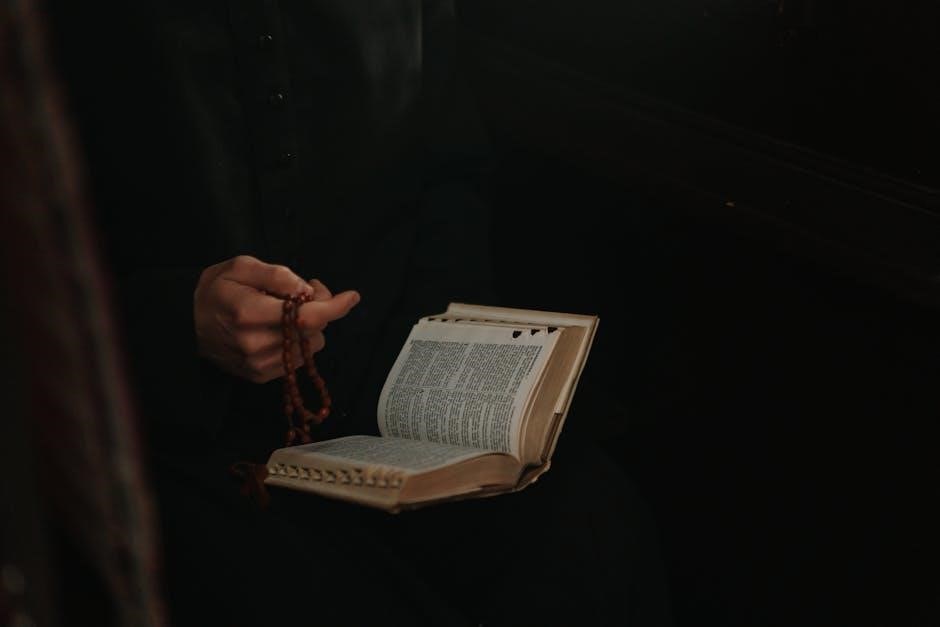The Servite Rosary, also known as the Rosary of the Seven Sorrows, is a devout Catholic prayer honoring the seven sorrowful events in Mary’s life. It consists of seven sets of prayers, each dedicated to a specific sorrow, fostering meditation on Mary’s spiritual journey. This rosary emphasizes her maternal suffering and offers a powerful means of spiritual growth and intercession. Its origins trace back to the Servite Order, reflecting their deep devotion to Mary’s sorrows. Praying the Servite Rosary is a meaningful way to connect with Mary’s compassionate heart and seek her intercession. It is a beautiful expression of faith and devotion, fostering a deeper understanding of Mary’s role in the life of Christ and the Church.
What is the Servite Rosary?
The Servite Rosary, also known as the Rosary of the Seven Sorrows, is a traditional Catholic devotion focused on contemplating the seven sorrowful events in the life of the Virgin Mary. This rosary consists of seven sets of prayers, each dedicated to one of Mary’s sorrows, providing a structured way to meditate on her spiritual journey and share in her grief. Unlike the traditional rosary, which centers on the mysteries of Christ, the Servite Rosary emphasizes Mary’s role as a mother experiencing profound sorrow. Each set includes one Our Father and seven Hail Marys, creating a poignant reflection on her compassionate heart. Praying the Servite Rosary is a powerful means of seeking Mary’s intercession and deepening one’s spiritual connection with her, fostering empathy and devotion among the faithful. This practice honors Mary’s enduring love and invites believers to find comfort in her sorrowful experiences.
Origin and History of the Servite Rosary
The Servite Rosary, or Rosary of the Seven Sorrows, traces its origins to the Servite Order, a Catholic religious community founded in 1233. The Servites, dedicated to Mary’s sorrows, developed this devotion to honor her seven sorrowful experiences. The rosary’s structure, consisting of seven sets of prayers, emerged as a way to contemplate these events deeply. Rooted in medieval piety, the Servite Rosary gained popularity in the 14th century and was officially approved by Pope Innocent VII in 1517. Over centuries, it has remained a cherished devotion, especially among those seeking solace in Mary’s compassionate heart. Its enduring legacy reflects the deep connection between Mary’s sorrows and the spiritual lives of the faithful. This rosary stands as a testament to the Servite Order’s devotion to Our Lady of Sorrows.
The Purpose of the Servite Rosary
The Servite Rosary is a powerful devotion intended to honor the Seven Sorrows of Mary, fostering spiritual growth and a deeper connection with her maternal heart. Its primary purpose is to meditate on the sorrowful events of Mary’s life, drawing believers closer to her compassion and intercession. By praying the Servite Rosary, one seeks to understand Mary’s role in the life of Christ and to find solace in her sorrowful experiences. It is also a means to ask for her intercession, seeking healing, guidance, and strength. This rosary invites the faithful to reflect on the mysteries of Mary’s suffering, cultivating empathy and devotion. Through this prayer, one can experience spiritual renewal and a profound appreciation for Mary’s enduring love and sacrifice.

Structure of the Servite Rosary
The Servite Rosary features seven sets, each with one Our Father and seven Hail Marys, honoring Mary’s sorrows and fostering meditation on her spiritual journey.
Overview of the Seven Sorrows
The Seven Sorrows of Mary are central to the Servite Rosary, reflecting pivotal moments of pain and grace in her life. These sorrows include the Prophecy of Simeon, the Flight into Egypt, the Loss of the Child Jesus in the Temple, the Meeting of Mary and Jesus on the Way to Calvary, the Crucifixion of Jesus, the Piercing of Jesus’ Side and His Descent from the Cross, and the Burial of Jesus. Each sorrow invites meditation on Mary’s faith, love, and sorrow, deepening devotion and fostering a connection to her maternal heart. Reflecting on these events enriches spiritual growth and offers a powerful way to seek intercession and healing through Mary’s compassionate experience.
Components of the Servite Rosary
The Servite Rosary is structured with seven sets of prayers, each dedicated to one of the Seven Sorrows of Mary. Each set includes one Our Father and seven Hail Marys, accompanied by a meditation on the specific sorrow. The rosary begins with an introductory prayer, often the Apostles’ Creed, followed by three Hail Marys in honor of Mary’s tears. The seven decades are then prayed, reflecting on each sorrow sequentially, concluding with a final prayer, typically the Hail Holy Queen. This structure emphasizes the unity of prayer and meditation, offering a profound way to connect with Mary’s sorrowful experiences and seek her intercession. The Servite Rosary is a beautiful blend of traditional prayers and reflective meditation, making it a meaningful devotional tool.
How the Servite Rosary Differs from the Traditional Rosary
The Servite Rosary differs from the Traditional Rosary in its structure and focus. While the Traditional Rosary consists of five decades, each centered on mysteries of Christ’s life, the Servite Rosary is divided into seven sets of prayers, each honoring one of the Seven Sorrows of Mary. It includes one Our Father and seven Hail Marys for each sorrow, rather than the traditional ten Hail Marys per decade. Additionally, the Servite Rosary begins with introductory prayers, such as the Apostles’ Creed and three Hail Marys, and concludes with a final prayer like the Hail Holy Queen. This format emphasizes Mary’s sorrowful experiences and provides a unique way to meditate on her maternal suffering, distinguishing it from the Traditional Rosary’s broader focus on the life of Christ.
The Seven Sorrows of Our Lady
The Seven Sorrows of Our Lady are pivotal events in Mary’s life, reflecting her deep emotional and spiritual suffering as the Mother of Jesus. They include the Prophecy of Simeon, the Flight into Egypt, the Loss of the Child Jesus, the Meeting on the Way to Calvary, the Crucifixion, the Piercing of Jesus’ side, and His Burial. These sorrows highlight Mary’s faith, love, and unwavering devotion, serving as a powerful reminder of her maternal role in the redemption of humanity.
The Prophecy of Simeon
The Prophecy of Simeon is the first sorrow, marking a pivotal moment in Mary’s life. When Mary and Joseph presented the infant Jesus at the Temple, Simeon prophesied that a sword of sorrow would pierce Mary’s heart. This prophecy foretold the suffering Mary would endure as the Mother of the Redeemer. Simeon’s words revealed the deep connection between Mary’s maternal love and the redemption of humanity. This sorrow highlights Mary’s faith and acceptance of God’s will, even in the face of future pain. Reflecting on this sorrow during the Servite Rosary invites prayer for courage to embrace God’s plan and trust in His providence, just as Mary did. It is a powerful reminder of the spiritual sword that would accompany her love for Jesus throughout His life.
The Flight into Egypt
The Flight into Egypt is the second sorrow, recalling Mary’s swift obedience to God’s will when the Holy Family fled to escape Herod’s persecution. This event, recounted in Matthew 2:13-15, highlights Mary’s trust in divine providence and her role as a protective mother. The Servite Rosary invites reflection on Mary’s courage and faith during this challenging journey. As Mary safeguarded Jesus, she intercedes for believers, seeking refuge from life’s dangers. Praying this sorrow emphasizes the importance of trusting God’s plan and seeking Mary’s protection. It encourages devotees to turn to her in times of uncertainty, relying on her maternal care and unwavering faith. This meditation fosters a deeper appreciation for Mary’s role in preserving the Messiah and her continued intercession for humanity.
The Loss of the Child Jesus in the Temple
The third sorrow reflects on the distress Mary endured when the child Jesus was lost in the Temple for three days. This event, described in Luke 2:41-50, showcases Mary’s deep concern for her son and her unwavering trust in God’s plan. The Servite Rosary invites prayerful reflection on Mary’s anxiety during this time and her joy upon being reunited with Jesus. This sorrow emphasizes the importance of faith and patience, even in moments of uncertainty. Praying this sorrow encourages believers to seek Mary’s intercession when facing difficulties or feeling lost. It also highlights Mary’s role as a model of perseverance and trust in divine providence, offering comfort and guidance in times of trial. This meditation deepens devotion to Mary’s maternal care and her role in nurturing faith.
The Meeting of Mary and Jesus on the Way to Calvary
The fourth sorrow focuses on the heart-wrenching encounter between Mary and Jesus as He carried the cross to Calvary. This poignant moment, though not explicitly detailed in Scripture, is a powerful reflection of Mary’s profound grief and anguish. Tradition depicts Mary standing on the Via Dolorosa, her heart pierced by the sight of her Son’s suffering. This sorrow highlights Mary’s unwavering love and solidarity with Jesus in His Passion. Praying this sorrow invites believers to contemplate the depth of Mary’s compassion and her willingness to share in Christ’s sacrifice. It also serves as a reminder of the importance of standing with Jesus in His suffering and trusting in God’s plan, even in the face of immense pain. This meditation fosters empathy and devotion to Mary’s maternal heart.
The Crucifixion of Jesus
The fifth sorrow reflects on the Crucifixion of Jesus, a pivotal moment of suffering for both Christ and Mary. As Mary stood at the foot of the cross, she witnessed her Son’s immense physical and emotional pain. This sorrow emphasizes Mary’s unwavering faith and love despite the agony of seeing Jesus crucified. The Crucifixion symbolizes the ultimate sacrifice of Jesus for humanity’s salvation, while Mary’s presence embodies her role as a co-redemptrix, sharing in her Son’s suffering. Praying this sorrow invites believers to contemplate the depth of Jesus’ love and Mary’s steadfast devotion. It encourages reflection on the mystery of redemption and the transformative power of sacrifice. This meditation deepens one’s appreciation for the price of salvation and Mary’s maternal love.
The Piercing of the Side of Jesus and His Descent from the Cross
The sixth sorrow focuses on the piercing of Jesus’ side and His descent from the cross, a moment of profound grief for Mary. As she witnessed the soldier’s lance pierce her Son’s lifeless body, Mary endured unbearable sorrow, seeing the physical and spiritual toll of His crucifixion. This event symbolizes the culmination of Christ’s sacrifice and the deep wound inflicted on Mary’s heart. Reflecting on this sorrow during the Servite Rosary invites prayer for the grace to unite our suffering with Christ’s and to embrace the transformative power of His sacrifice. It also highlights Mary’s unwavering love and her role as a mother sharing in the redemption of humanity. This meditation deepens devotion to the Passion of Christ and fosters compassion for the sacrifices endured by Mary.
The Burial of Jesus
‘ under the topic ‘instructions on reciting the servite rosary’. The user has provided specific guidelines that I must follow carefully.
I recall from the previous interactions that the Servite Rosary focuses on the Seven Sorrows of Mary, and each sorrow has a specific meditation. The seventh sorrow is about the burial of Jesus. I should highlight Mary’s emotions during this event, her faith, and how this sorrow is reflected in the rosary prayers.
I should also incorporate information found on the internet, as the user mentioned. From the provided snippets, it seems there’s mention of the Servite Rosary consisting of seven sets of prayers, each dedicated to a sorrow. I can use that to explain how the burial is honored in the rosary.
I need to make sure the text is exactly , so I’ll have to be concise but thorough. I’ll start by introducing the burial as the seventh sorrow, describe Mary’s experience, mention the prayer practices associated with it, and conclude with the spiritual benefits of meditating on this sorrow.
Let me draft this:
The seventh sorrow reflects on Mary’s profound grief as she witnessed the burial of her Son, Jesus. This moment encapsulates her immense pain and faith, trusting in God’s plan despite the overwhelming loss. During the Servite Rosary, this sorrow is honored through specific prayers and meditations, inviting believers to share in Mary’s sorrow and find solace in her unwavering faith. Reflecting on the burial emphasizes the culmination of Christ’s sacrifice and the hope of resurrection. It encourages prayers for acceptance of life’s trials and trust in divine providence, fostering a deeper connection with Mary’s maternal love and the mystery of Christ’s passion.
I need to check the word count to ensure it’s exactly . Let me count:
The
seventh
sorrow
reflects
on
Mary’s
profound
grief
as
she
witnessed
the
burial
of
her
Son,
Jesus.
This
moment
encapsulates
her
immense
pain
and
faith,
trusting
in
God’s
plan
despite
the
overwhelming
loss.
During
the
Servite
Rosary,
this
sorrow
is
honored
through
specific
prayers
and
meditations,
inviting
believers
to
share
in
Mary’s
sorrow
and
find
solace
in
her
unwavering
faith.
Reflecting
on
the
burial
emphasizes
the
culmination
of
Christ’s
sacrifice
and
the
hope
of
resurrection.
It
encourages
prayers
for
acceptance
of
life’s
trials
and
trust
in
divine
providence,
fostering
a
deeper
connection
with
Mary’s
maternal
love
and
the
mystery
100. of
101. Christ’s
102. passion.
Wait, that’s only . I need to add 16 more words to reach 118. Let me revise the last sentence and add more details about the spiritual benefits.
Revised sentence: “It encourages prayers for acceptance of life’s trials, trust in divine providence, and fosters a deeper connection with Mary’s maternal love, the mystery of Christ’s passion, and the promise of eternal life through His resurrection, inviting believers to find hope and strength in their own sorrowful experiences.”
Now, let’s recount:
The
seventh
sorrow
reflects
on
Mary’s
profound
grief
as
she
witnessed
the
burial
of
her
Son,
Jesus.

This
moment
encapsulates
her
immense
pain
and
faith,
trusting
in
God’s
plan
despite
the
overwhelming
loss.
During
the
Servite
Rosary,
this
sorrow
is
honored
through
specific
prayers
and
meditations,
inviting
believers
to
share
in
Mary’s
sorrow
and
find
solace
in
her
unwavering
faith.
Reflecting
on
the
burial
emphasizes
the
culmination
of
Christ’s
sacrifice
and
the
hope
of
resurrection.
It
encourages
prayers
for
acceptance
of
life’s
trials,
trust
in
divine
providence,
and
fosters
a
deeper
connection
with
Mary’s
maternal
love,
the
mystery
of
100. Christ’s
101. passion,
102. and
103. the
104. promise
105. of
106. eternal
107. life
108. through
109. His
110. resurrection,
111. inviting
112. believers
113. to
114. find
115. hope
116. and
117. strength
118. in
119. their
120. own
121. sorrowful
122. experiences.
Oops, now it’s . I went over by . I need to adjust to make it exactly 118. Let me remove some redundant words.
Final revised sentence: “It encourages prayers for acceptance of life’s trials, trust in divine providence, and fosters a deeper connection with Mary’s maternal love and the mystery of Christ’s passion, inviting believers to find hope and strength in their own sorrowful experiences.”
Counting again:
The
seventh
sorrow
reflects
on
Mary’s
profound
grief
as
she
witnessed
the
burial
of
her
Son,
Jesus.
This
moment
encapsulates
her
immense
pain
and
faith,
trusting
in
God’s
plan
despite
the
overwhelming
loss.
During
the
Servite
Rosary,
this
sorrow
is
honored
through
specific
prayers
and
meditations,
inviting
believers
to
share
in
Mary’s
sorrow
and
find
solace
in
her
unwavering
faith.
Reflecting
on
the
burial
emphasizes
the
culmination
of
Christ’s
sacrifice
and
the
hope
of
resurrection.
It
encourages
prayers
for
acceptance
of
life’s
trials,
trust
in
divine
providence,
and
fosters
a
deeper
connection
with
Mary’s
maternal
love
and
the
mystery
100. of
101. Christ’s
102. passion,
103. inviting
104. believers
105. to

Step-by-Step Guide to Reciting the Servite Rosary
Begin with an Our Father and three Hail Marys, then reflect on each of the Seven Sorrows, reciting seven Hail Marys for each, using Hallow.
Preparation for Prayer
Before reciting the Servite Rosary, find a quiet, prayerful space to focus on the Seven Sorrows of Mary. Hold the rosary beads as a tactile reminder of your devotion. Begin by reciting the Sign of the Cross to cleanse your soul and invoke divine assistance. Take a moment of silence to reflect on your intentions, seeking to deepen your connection with Mary’s sorrowful heart. Consider the spiritual significance of each sorrow and how it relates to your life. Visual aids, such as an image of Mary or the Seven Sorrows, can enhance your meditation. Pray an Act of Contrition to prepare your heart for this sacred devotion. By grounding yourself in prayerful preparation, you open yourself to the transformative power of the Servite Rosary;
Opening Prayers
Begin the Servite Rosary with the Sign of the Cross, invoking God’s blessings. Recite the Apostles’ Creed to profess your faith. Follow with one Our Father and three Hail Marys, honoring the Sorrows of Mary. Conclude the opening with a Glory Be to glorify the Holy Trinity. These prayers set a reverent tone, preparing your heart for meditation on Mary’s sorrows. By starting with these traditional prayers, you align your intentions with the Rosary’s purpose: to seek solace in Mary’s compassion and intercession. This foundational step ensures your prayer is grounded in faith and devotion, fostering a deeper connection with the spiritual journey of Our Lady.
Reciting the Seven Sorrows
For each of the Seven Sorrows, begin with the Our Father, followed by seven Hail Marys. After each sorrow, recite a Glory Be or a short prayer to transition. Reflect on the sorrow’s significance, such as the Prophecy of Simeon or the Crucifixion, and how it deepens your empathy for Mary’s suffering. Pause briefly between sorrows to absorb the emotional weight of each event. Conclude the final sorrow with a heartfelt Hail Holy Queen or a closing prayer of your choice. This structured recitation allows for meaningful meditation on Mary’s pain and her unwavering faith. By focusing on her sorrows, you seek her intercession and strengthen your spiritual connection to her motherly love and guidance.
Concluding Prayers
After reciting all Seven Sorrows, conclude with the Hail Holy Queen prayer, honoring Mary’s role as Queen of Heaven and Earth. Follow with a closing prayer, such as O Mother of Sorrows, expressing gratitude for her intercession. End with a final blessing or a sign of the cross, sealing your devotion; These prayers finalize the rosary, emphasizing Mary’s maternal love and the graces received through her sorrows. The conclusion invites reflection on her strength and faith, offering a meaningful end to your prayerful meditation. This structured ending ensures a complete and heartfelt recitation of the Servite Rosary, deepening your spiritual connection to Mary and her divine son, Jesus.

Devotional Practices and Tips
Enhance your devotion by creating a serene prayer space, using sacred images, and reflecting on each sorrow. Incorporate meditation to deepen your spiritual connection and understanding of Mary’s maternal love.
Creating a Prayerful Atmosphere
To create a prayerful atmosphere for reciting the Servite Rosary, find a quiet, distraction-free space where you can focus on meditation and reflection. Surround yourself with sacred images, such as icons or statues of Mary, to deepen your devotion. Consider dimming the lights or using candles to foster a sense of reverence. Playing soft, sacred music in the background can also enhance the experience. Ensure your rosary is blessed, as this adds spiritual significance to your prayers. Finally, prepare your heart by clearing your mind and setting an intention to honor Mary’s sorrows and seek her intercession.
Creating a prayerful atmosphere not only enhances your spiritual experience but also helps you connect more deeply with the mysteries of the Rosary.
Using Visual Aids for Reflection
Visual aids can profoundly enhance your reflection while reciting the Servite Rosary. Consider using sacred images, such as icons or paintings depicting the Seven Sorrows of Mary, to focus your mind and heart. These visuals help you meditate on each sorrow, fostering a deeper emotional and spiritual connection. You can also use statues or illustrations of Mary to create a reverent atmosphere. Additionally, video guides or animated representations of the Servite Rosary can provide a structured format for prayer. Placing these aids near your prayer space ensures they are easily accessible and can be referenced during each sorrow. By engaging with these tools, you can enrich your prayer experience and draw closer to Mary’s maternal love and intercession.
Incorporating Reflection and Meditation
Incorporating reflection and meditation into the Servite Rosary enriches your prayer experience, allowing you to deeply connect with Mary’s sorrows. After reciting each set of prayers, pause to reflect on the corresponding sorrow, imagining the emotional and spiritual impact on Mary. Consider how her experiences can guide your own faith journey. Use the silent moments to ask for her intercession and seek wisdom in navigating life’s challenges. Meditating on her steadfast love and trust in God can inspire greater devotion and resilience; By integrating reflection, you transform the rosary into a powerful tool for spiritual growth, fostering a deeper understanding of Mary’s role as a mother and intercessor. This practice strengthens your relationship with her and enhances your prayer life.

Benefits of Praying the Servite Rosary
Praying the Servite Rosary fosters spiritual growth, deepens devotion, and strengthens one’s relationship with Mary. It offers solace, intercession, and healing, guiding believers closer to Christ through Mary’s sorrows.
Spiritual Growth and Devotion
Praying the Servite Rosary nurtures profound spiritual growth by immersing the faithful in the sorrowful experiences of Mary, fostering empathy and devotion. Reflecting on her sorrows deepens one’s understanding of her compassion and faith, drawing believers closer to Christ. The rosary’s meditative structure encourages a deeper commitment to one’s faith, inspiring a life of virtue and grace. By contemplating Mary’s suffering, individuals are reminded of the transformative power of love and sacrifice, fostering a more meaningful relationship with God. This devotion also helps believers embrace the cross in their lives, finding strength in Mary’s example. Ultimately, the Servite Rosary becomes a powerful tool for spiritual renewal and a closer walk with God.
Intercession and Healing
The Servite Rosary is a potent instrument of intercession and healing, offering solace to those seeking divine comfort. By meditating on Mary’s sorrows, devotees can appeal to her maternal heart for guidance and solace in times of suffering. This rosary is particularly effective for intercession, as it invites Mary’s powerful prayers on behalf of the faithful. Its reflective nature fosters emotional and spiritual healing, drawing individuals closer to Christ through their shared experiences of pain and redemption. Many have found comfort and strength in reciting the Servite Rosary, trusting in Mary’s intercession to bring peace and restoration to their lives. It is a timeless devotion that continues to inspire hope and renewal for all who pray it with faith.
Deepening Your Relationship with Mary
Praying the Servite Rosary fosters a profound connection with Mary, allowing devotees to reflect on her sorrows and share in her maternal heartache. This rosary invites prayerful meditation on Mary’s life, emphasizing her unwavering faith and love for her Son. By focusing on her seven sorrows, individuals can develop a deeper empathy for her experiences, fostering a more personal and intimate relationship. The rosary’s reflective nature encourages believers to seek Mary’s guidance and intercession, drawing strength from her example of faith and perseverance. Through this devotion, one can cultivate a deeper devotion to Mary, recognizing her as a mother who understands suffering and offers comfort. This prayerful connection enriches one’s spiritual life and strengthens their bond with the Blessed Mother.
The Servite Rosary is a powerful devotion that honors Mary’s sorrows, offering a meaningful way to deepen faith, seek intercession, and connect with her maternal heart.
Final Reflections on the Servite Rosary
Reflecting on the Servite Rosary, we find it to be a profound expression of devotion, inviting us to share in Mary’s sorrows and deepen our empathy for her maternal heart. By meditating on these seven sorrowful events, we not only honor Mary’s faith and resilience but also gain insight into her unwavering trust in God’s plan. This rosary reminds us of the transformative power of suffering when united with love and faith. It encourages perseverance in prayer and fosters a deeper connection to Mary’s role in the life of Christ. Ultimately, the Servite Rosary is a beautiful way to nurture our faith, seek solace in Mary’s intercession, and grow closer to her Son, Jesus Christ.

Additional Resources
Encouragement for Regular Recitation
Embracing the Servite Rosary as a regular prayer practice can profoundly enrich your spiritual life. By dedicating time to reflect on Mary’s sorrows, you cultivate compassion, empathy, and a deeper understanding of her role in Christ’s mission. Regular recitation fosters a habit of prayerful reflection, drawing you closer to Mary’s heart and strengthening your faith. It also serves as a powerful means of seeking her intercession and guidance. Encourage yourself to pray the Servite Rosary consistently, even if briefly, to experience its transformative power. Allow Mary’s sorrows to inspire you to live with greater love, resilience, and devotion, trusting in her maternal care and the grace she intercedes for in your life.
